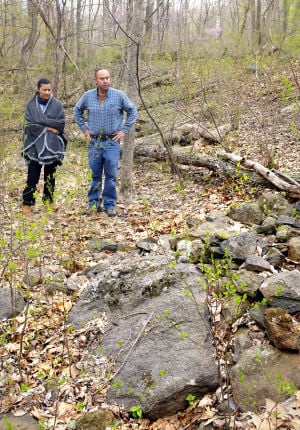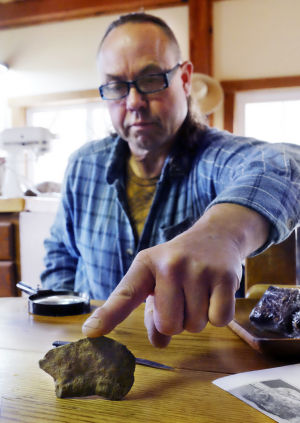Site could be one of the oldest man-made structures still standing in North America.

 Concentric stone circles near rocks weighing more than a ton —
apparently aligned to mark solar events — are believed to be part of a
Paleo-Indian site in the Blue Ridge Mountains of Clarke County that an
expert has dated to about 10,000 B.C.
The complex along
Spout Run has 15 above-ground stone features. Though still under study,
it could be one of the oldest man-made structures in North America still
in existence and twice as old as England’s Stonehenge.
Chris and Rene White, who own the property and
made the initial discovery, credit their Native American heritage for
the finding.
Concentric stone circles near rocks weighing more than a ton —
apparently aligned to mark solar events — are believed to be part of a
Paleo-Indian site in the Blue Ridge Mountains of Clarke County that an
expert has dated to about 10,000 B.C.
The complex along
Spout Run has 15 above-ground stone features. Though still under study,
it could be one of the oldest man-made structures in North America still
in existence and twice as old as England’s Stonehenge.
Chris and Rene White, who own the property and
made the initial discovery, credit their Native American heritage for
the finding.When Chris White, who is of Cherokee descent, was building a home for himself and his wife — who is a Lumbee Indian — on the wooded land, he said he often took a break to walk by Spout Run, which tumbles downhill in its rocky bed across his land.
Something told him that the area was important, and he decided to create a stone medicine wheel on the 20-acre property below Bears Den Trail Center — a lodge owned by the Appalachian Trail Conservancy.
To his surprise, he realized the area across the stream already had a stone circle. In fact, it had several concentric stone circles.
For a professional opinion, the Whites contacted retired archaeologist Jack Hranicky, of Alexandria, who had investigated five other Paleo-Indian sites in Virginia.
It was Hranicky who realized the rocks in and outside the circles aligned with special features on the Blue Ridge.
A line from a center rock, over a specific boundary rock, intersects the feature called Bears Den Rocks on the mountain. Standing on that center rock, looking northeast, a viewer can see the sun rise over Bears Den on the day of the summer solstice in June.
Moving around the circle, another set of rocks points to Eagle Rock on the Blue Ridge, and also to sunrise on the day of the spring and fall equinox in March and September.
Yet a third points to a saddle in the mountain, where the sun rises at the winter solstice in December.
To date the age of the site, Hranicky excavated an area of 5 square feet, carefully numbering every rock and setting it aside, to be replaced later.
He wanted to create as little disturbance as possible in hopes that future technology will have better methods of studying the site.
His digging exposed three artifacts — a thin blade of quartzite, a small piece of jasper and another piece of the rock that had been shaped to be used as a small scraper.
Hranicky believes the jasper ties the Spout Run site to the Thunderbird Archaeological District, an intensely excavated Paleo-Indian site on the Shenandoah River in Warren County.
There, 9,000 years ago, Paleo-Indians — who Hranicky calls Virginia’s first engineers — quarried jasper from the river’s west bank to make tools.
Hranicky suggests that after quarrying jasper for tools at Thunderbird, Native Americans walked down the Shenandoah River and held some sort of cultural ceremonies at the Spout Run site. Rock engravings in the shape of footprints could be intended to mark where to stand to observe an equinox.
To get some idea of the site’s age, a section of jasper from the Spout Run site was sent to James Feathers, who runs the Luminescence Dating Laboratory at the University of Washington in Seattle.
According to Feathers, the piece of jasper found along Spout Run was heated, perhaps in a campfire, and it’s possible to determine by the proportion of luminescence when that occurred.
The date when that piece of jasper was burned on the Blue Ridge, Chris White said, is about 10,470 B.C.
While the concentric rock circles and sight lines appear to connect the site to the solar year, other objects found on the ground seem to speak about ceremonies held there.
The palm-sized pieces of stone appear to depict animals, like bear, mammoth and bison.
It takes someone with a background in stone work to pick out these effigies, White said, to understand the difference in a “worked stone.”
His most recent find is a lot bigger.
Higher up the mountain are several large boulders that appear to have been stacked on top of each other to create a table-like structure.
The boulders, two wide and two high, have been “artificially shimmed, to try to make it as flat and level as possible,” Chris pointed out.
The top boulder on the west is a single rock, but the back half of the table top is two separate rocks.
At certain times of the year, the sun, at midday, shines directly down into the center split.
“It’s almost like Indiana Jones,” he said.

No comments:
Post a Comment